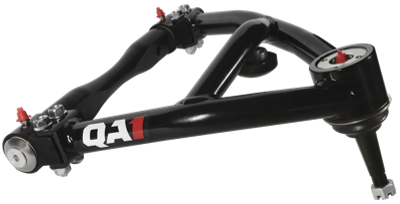How to Tune Your Shocks For a Smooth Ride
Congratulations on the installation of your new adjustable QA1 shocks! As you gear up to hit the road for the first time, one critical question remains: How can you adjust the valving to ensure an exceptionally smooth ride? In this blog post, we will guide you through a step-by-step process to fine-tune your QA1 shocks, placing a strong emphasis on optimizing ride quality during your initial drive. Whether you're a street driver seeking enhanced comfort or looking to achieve a plush and refined ride, this article is tailored to help you achieve the ultimate in ride smoothness.
- Getting started with QA1 Shocks
- Choosing the right road to test
- Adjusting single adjustable shocks
- Fine-tuning double adjustable shocks
- Striking a front and rear balance
Starting with a Clean Slate
When embarking on the setup of your QA1 shocks, it's highly recommended to begin with the shocks set at full zero, also known as the full counterclockwise position. Whether you're equipped with QA1 double adjustable or single adjustable shocks, each knob offers 18 distinct clicks for adjustment.
By selecting the zero setting as your starting point, you establish a baseline for future adjustments. This initial configuration represents the softest setting, enabling you to thoroughly test, compare, and fine-tune your QA1 shocks to achieve the desired ride quality and performance.
Choose the Right Road to Test
Consistency is key when it comes to testing your shocks, so it's essential to avoid driving in a continuous loop where you may not encounter the same types of surfaces you wish to optimize for. Instead, seek out a road that offers a variety of conditions. Look for a route that has straight-line sections, curves for testing handling, and areas with bumps or imperfections to evaluate overall ride quality.
When making adjustments, prioritize safety by choosing a safe spot off the road where you can pull over and conveniently fine-tune the shocks. A driveway, parking lot, or any other area away from traffic would be ideal.
Adjusting Single Adjustable Shocks
For those equipped with QA1 single adjustable shocks, the process of fine-tuning is simplified yet still effective. With a single adjustment knob, you have the ability to control both compression and rebound simultaneously. Begin with the shocks set at full zero, the softest setting, as your starting point. Gradually increase the valving by turning the adjustment knob clockwise, incrementally dialing in the shocks to find the sweet spot that balances comfort and performance. Remember to take your time and experiment with different settings, allowing yourself to experience the changes in ride quality and handling characteristics at each adjustment level.
Fine-Tuning Double Adjustable Shocks
For those with QA1 double adjustable shocks, the adjustment process offers even more versatility and precision. With separate knobs controlling compression and rebound, you have the opportunity to independently tune each aspect to suit your desired ride characteristics. Start by setting both knobs to the full zero position, establishing a baseline for your initial drive. As you embark on your test drive, pay close attention to the behavior of the shocks in different scenarios. Adjust the compression knob first, making small incremental changes to find the ideal balance between firmness and comfort. Then, focus on the rebound knob, fine-tuning its setting to optimize handling and overall ride quality. By adjusting each knob and taking note of the changes in the car's response, you can achieve a highly personalized and refined ride experience. Take the time to experiment and find the perfect combination that delivers the smoothness, control, and performance you desire.
No matter which type of QA1 shocks you have, whether single or double adjustable, the key is to approach the adjustment process with patience and a willingness to experiment. Remember that every car and driver preference is unique, so the optimal setting may vary. Enjoy the journey of fine-tuning your QA1 shocks, and revel in the enhanced comfort, control, and driving pleasure that await you on the open road.
Striking a Front and Rear Balance
When fine-tuning your shocks, pay careful attention to the behavior of both the front and rear of your vehicle. A useful guideline to follow is: if you feel vibrations in your feet, they likely originate from the front; if you feel them in your seat, they likely originate from the rear. Additionally, take into consideration the type of suspension your car features. Shocks will respond differently depending on whether your vehicle has a solid axle or independent front suspension. As a general rule, it's common to run the rear shocks slightly softer than the fronts.
Final Thoughts
As we wrap up, we want to remind you that there is no universal solution when it comes to dialing in your QA1 shocks for the perfect ride. Take your time, explore the full range of adjustment, and fine-tune your shocks with incremental tweaks. Pay attention to the balance between the front and rear behavior, ensuring both have a smooth ride.
So, have fun with it … and remember to share your remarkable experiences with us by using the hashtag #goDRIVEit. Safe travels and enjoy the road!

